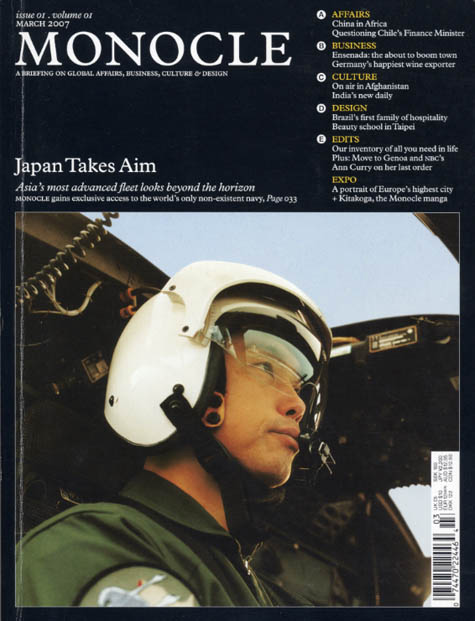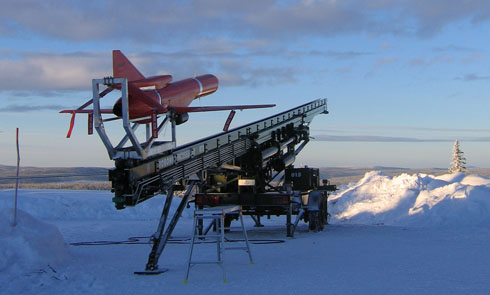The new magazine Monocle has been getting loads of press lately, from both lovers and haters; and while I can’t necessarily say that I’m one or the other, I will admit to erring on the side of enthusiasm.
There’s some great stuff in there.
 I’ve only got the first issue, however, so I’m not exactly an informed reader; and I won’t be performing a rigorous review of the magazine here – discussing its design, intentions, etc. etc. etc. I simply want to point out a few cool articles that have an architectural or landscape bent.
I’ve only got the first issue, however, so I’m not exactly an informed reader; and I won’t be performing a rigorous review of the magazine here – discussing its design, intentions, etc. etc. etc. I simply want to point out a few cool articles that have an architectural or landscape bent.
Which is quite a large part of the magazine, as it happens.
First, for instance, we take a brief trip to Paris, where we step down onto the Champs-Elysées and learn that a Citroën “flagship showroom” will soon open up, putting shiny cars with waxed bonnets on display in the window. Then there’s a glossy photo-essay on Le Chaux-de-Fonds, Switzerland, “the city were timing is everything” (they manufacture watches). And there’s a quick visit to the nearby town of Sedrun, Switzerland, where the Gotthard Base Tunnel “is being dug more than 600m below the [earth’s surface], through nearly 58km of Massif stone.” A subterranean train station, located at the midpoint of the tunnel, will be “linked to the surface by the world’s tallest lift.” Long-term readers may note that this same tunnel was mentioned on BLDGBLOG back in December.
 [Image: Gotthard Base Tunnel, via Wikipedia].
[Image: Gotthard Base Tunnel, via Wikipedia].
Awesomely, Monocle then turns its cyclopean gaze onto the empty skies above Kemijärvi, Finland, north of the Arctic Circle, where “a test centre for unmanned aerial vehicles (UAVs)” has opened. The test center is run by a firm called Robonic; Robonic “has taken advantage of the vast, virtually unused airspace – a rarity in Europe – above Finnish Lapland to create the only private test centre in the world devoted solely to UAVs.” This would also seem to be the perfect setting for a new novel by J.G. Ballard. Or an Alfred Hitchcock film: unmanned drones fly state secrets across the Arctic Circle…
Meanwhile, could you use these launchers, I wonder, to hurl small buildings into the sky? And if you could, would you do it?
Frustratingly, the article doesn’t ask these questions.
 [Image: The launcher for a UAV; courtesy of Robonic].
[Image: The launcher for a UAV; courtesy of Robonic].
Moving on, we read, Budapest wants to clean up its river; as it is, the Danube is now “a muddy grey-brown, thanks in part to the sewage gushing out underneath Elizabeth Bridge” – which is a structure, not a woman.
Apparently a “warehouse district” will soon be built, modeled after the Docklands in London.
There’s also a great article on China’s bankrolling of infrastructural construction projects throughout Africa:
China’s influence in Africa is growing at an unprecedented rate. Across the continent the Chinese are building stadiums, parliaments, roads, offering their expertise as well as they wallet. But China is not just giving to Africa, it is taking too. By the end of next year China will have become the world’s largest importer of oil, and most of it will come from Africa. China is also in desperate need of minerals such as copper, aluminium and iron ore – and African nations are willing to provide them.
This topic was also previously explored on BLDGBLOG.
I’m going on a bit here, I have to say, but there’s even a feature-length exposé on Bartenbach LichtLabor (BLL) and their “daylight-redirection” scheme in Rattenberg, Austria – a project Pruned told us about so long ago.
Monocle explains how BLL plans “to create an elaborate system of heliostats and fixed mirrors that could bounce sunlight from a nearby mountaintop on to a hill opposite and into the main street’s gift shops and cafés.” Without these mirrors – and their “secondary mirrors,” in turn – the town would spend “almost four months of the year in the shadow of Rat mountain.” In the shadow of Rat mountain!
The English name alone would cause depression.
 [Image: The lighting technologies of Bartenbach LichtLabor].
[Image: The lighting technologies of Bartenbach LichtLabor].
To test these devices, BLL has constructed an “artificial sky… packed with fluorescent lamps, translucent lamps and LEDs.” It’s referred to as “the ultimate toy for a lighting geek.”
Anyway, I could go on and on – it’s an impressive magazine.
However, I do have to mention, finally, the one article I was actually intending to write about here before I started drinking coffee: on page 70, there’s a short, one-column piece about Alice Gorman.
Gorman is an Australian archaeologist whose university homepage states her interests as “material culture relating to space exploration, including terrestrial launch sites like Woomera (South Australia), Kourou (French Guiana) and Hammaguir (Algeria).” She also studies “orbital debris” and “planetary landing sites.”
Gorman’s got a blog called Space Age Archaeology; she’s got a research abstract online discussing “the archaeological record of human endeavours beyond the atmosphere” (!); and she’s got a downloadable PDF about all of the above. Vaguely similar topics, meanwhile, pop up in an old – and somewhat confusingly typeset – BLDGBLOG post called “White men shining lights into the sky“…
Monocle further tells us that Gorman has been “calling on the United Nations this month to create a protected ‘heritage list'” for orbital objects, “including the Vanguard 1 satellite, launched in 1958 and now the oldest man-made object in orbit.”
Gorman: “Maybe the only evidence that a country has a right to be in geostationary orbit will be [the presence of] an old satellite.” As space fills up with more and more junk – not to mention working satellites – she says: “It’s not impossible that being able to claim access to an orbit could be a bit like Aboriginal people in Australia being able to say, ‘This is where my ancestors camped.'”
 [Image: The International Space Station].
[Image: The International Space Station].
A few things: 1) Last week I interviewed science fiction novelist Kim Stanley Robinson for BLDGBLOG and I asked him about this very topic – directly referencing Monocle: will we yet see an archaeology of space, complete with in-orbit excavation sites, etc. etc. etc.? I hope to have that interview up and public within the month.
2) The very idea of an orbiting, geostationary archaeological site strikes me as so amazing, and so fun to think about, that I almost can’t believe it. What will happen, say, in 400 years, or 900 years, or 1500 years, when the International Space Station has become like Petra or Skara Brae or even Macchu Picchu – the lost and dusty relic of a dead civilization – visited by space tourists with a thing for archaeology, snapping photos of themselves beside old push-button consoles as the sun rises through command windows in the background…? Masked grad students earn summer credits in Forensic Anthropology, roping off portions of the Station, mapping ancient social dynamics as dictated by architectural space…
Ruins in orbit around the earth!
Anyway, I found the first issue of Monocle to be really exciting and well-done, and I’m looking forward to issues two, three, four, etc.
Although… note to Monocle: it is actually cheaper to buy the magazine issue by issue here in the States; subscribing is nearly 30% more expensive.
Sorry – I had to erase the previous comment because it included a link that was making the margins wonky. That comment, from y.e. vulva, said…:
the I.S.S. will be a footnote to the interplanetary space tunnel?
alternatively, see P.K.Dick’s “Dr. Bloodmoney” – a DJ space station orbiting a post-apocalyptic earth.
Looking forward to the Stan Robinson interview! In a couple of novels by SF author John Varley [golden globe? steel beach?] he describes the Apollo 11 site being entirely enclosed and nearly forgotten in the layers of construction on the moon. It’s a shrine of sorts, an old dusty spot that has little attention in the far future.
I *so* wanted to pick up Monocle the other day when I saw my first print copy. It’s been getting so much hype … I really wanted to love it.
But I didn’t love it, and I didn’t buy it, and your post here brings up some of the reasons why. I had already seen a lot of this material on the web, on BLDGBLOG and elsewhere.
What do you think that says about the percieved legitimacy of online publishing vs. off? It’s nice, for example, that now a lot of these references are in print, in Monocle, and someone can cite them in an academic context without looking like a total noob. But on the other hand, a lot of this stuff was more interesting when it was online, not the least because of the cloud of comments and other blog posts they would start to aggregate. This cloud itself being another, hyperaccelerated relative of the academic citation netowork.
In short I kind of feel like they were (in part) taking alot of interesting stuff that had originally broke on the web, and gone into it a little deeper and added some context, but in turn made it somehow secularized, and therefore less cool.
Erm… the ISS isn’t in GEO, it’s in LEO. Without upkeep, objects in LEO will eventually fall back to earth. Sorry to spoil a nice image.
Alright, I had to come back here and take it all back – I just picked up issue 2 and it’s fantastic, the writing, the layout, the photography … I believe the hype now. Really great indepth breakdown of complex issues from all over the place. I take it back, Monocle rocks! Here’s hoping they keep the momentum.
For a more visual interpretation of the anonymous comment above, see this chart:
http://www.heavens-above.com/issheight.asp
Not only is it a vast chunk of architecture flying around the planet 16 times a day, but the ISS is also constantly falling. It dropped 10km in a three month span before they re-boosted it in March. You wrote about an upward migrating void; ISS is the exact opposite: something migrating down through a void.
It’s unlikely that it will get the monthly maintenance required for it to still be in orbit in 40 years, let alone 400.